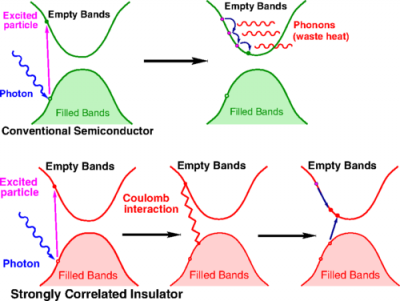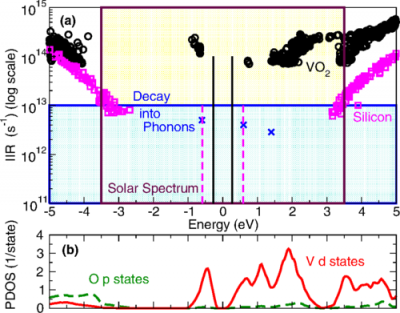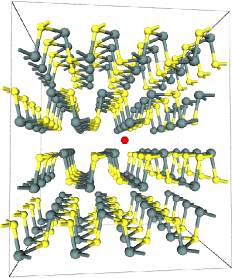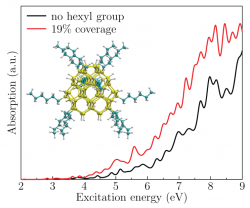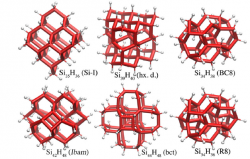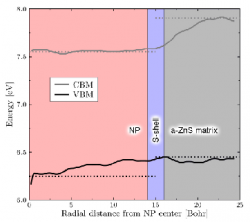Solar cells
We carry out search for third generation solar cells. Particularly, we seek and characterize such materials where thin-film or nanostructured semiconductors may show enhanced absorption and/or carrier multiplication for increased efficiency.
In collaboration with Manousakis group at Florida State University, we propose<bib id="PhysRevB.90.165142"/> that strongly correlated materials are strong candidates for realizing efficient photovoltaic cells because the enhanced carrier multiplication rates. The idea is sketched on the figure.
We have shown by first-principles calculations that the carrier multiplication rate is two orders of magnitude higher in VO2 than in Si and much higher than the rate of hot electron/hole decay due to phonons. As VO2 is a proto-typical material of strongly correlated materials, we think that the family of strongly correlated materials exhibit similar properties. This may lead to a single photon in - two electrons out operation of solar cells in strongly correlated materials that can significantly increase the efficiency of this type solar cells compared to the case of conventional semiconductors. <bib id="PhysRevB.90.165142"/>
Characterization of an efficient light absorber: point defects in tin monosulfide (SnS)
Tin monosulfide (SnS) is quasi-2D material which is a metastable crystalline form of Sn and S. From solar cell application point of view, the very attractive property of SnS is the strong absorption starting at about 1.3 eV. However, the real SnS material is very defective, and often exhibits unintentional p-type doping. In collaboration with Kaxiras group at Harvard University we found that for the intrinsic defect, Sn-vacancy acceptor defect is responsible for the intrinsic p-type conductivity of SnS. For the extrinsic defects, we find support for the experimental suggestion that P, under S-rich conditions, prefers to substitutionally occupy the Sn site rather than the S site, and this leads to n-type behavior. Additionally, we support that Sb acts as a donor in Sn. We also show that Cl prefers to substitute for S atoms where it acts as a donor.
Phys. Chem. Chem. Phys. on-line (2014). DOI:10.1039/C4CP03010A
Enhanced absorption and carrier multiplication in semiconductor nanoparticles
Surface effects on nanoparticle boundaries in solid-state matrix can help circumvent the limitations of traditional (first and second-generation) photovoltaics. This effect may be enhanced and fine-tuned by modifying the surface. The core aim of this strategy is to produce solid-state systems which absorb visible light, and in which the resulting high-energy exciton generates multiple charge carriers instead of decaying into a low-energy one and heat via phononic processes.
Tweaking the absorption of Si nanoparticles by surface engineering
Márton Vörös, Dario Rocca, Giulia Galli, Gergely T. Zimanyi, and Adam Gali, Increasing impact ionization rates in Si nanoparticles through surface engineering: A density functional study, Phys. Rev. B 87 155402 (2013) doi:10.1103/PhysRevB.87.155402
Adam Gali, Márton Vörös, Dario Rocca, Gergely T. Zimanyi, and Giulia Galli, High Energy Excitations in Silicon Nanoparticles,
Nano Lett. 9 3780–3785 (2009) doi:10.1021/nl901970u
Solution to the quantum confinement dilemma: enhanced carrier multiplication rates in the solar spectrum in Si and Ge metastable nanoparticles
S. Wippermann, M. Vörös, D. Rocca, A. Gali, G. Zimanyi, and G. Galli, High-Pressure Core Structures of Si Nanoparticles for Solar Energy Conversion, Phys. Rev. Lett. 110 046804 (2013) doi:10.1103/PhysRevLett.110.046804
M. Vörös, S. Wippermann, B. Somogyi, A. Gali, D. Rocca, G. Galli, and G. Zimanyi, Ge nanoparticles with non-diamond core structures for solar energy conversion, J. Mater. Chem. A 2 9820–9827 (2014) doi:10.1039/c4ta01
Efficient electron-hole separation for Si nanoparticles embedded into a matrix
S. Wippermann, M. Vörös, A. Gali, F. Gygi, G. Zimanyi, and G. Galli, Solar nanocomposites with complementary charge extraction pathways
for electrons and holes: Si embedded in ZnS, Phys. Rev. Lett. 112 106801 (2014) doi:10.1103/PhysRevLett.112.106801
Bibliography
<biblist />
